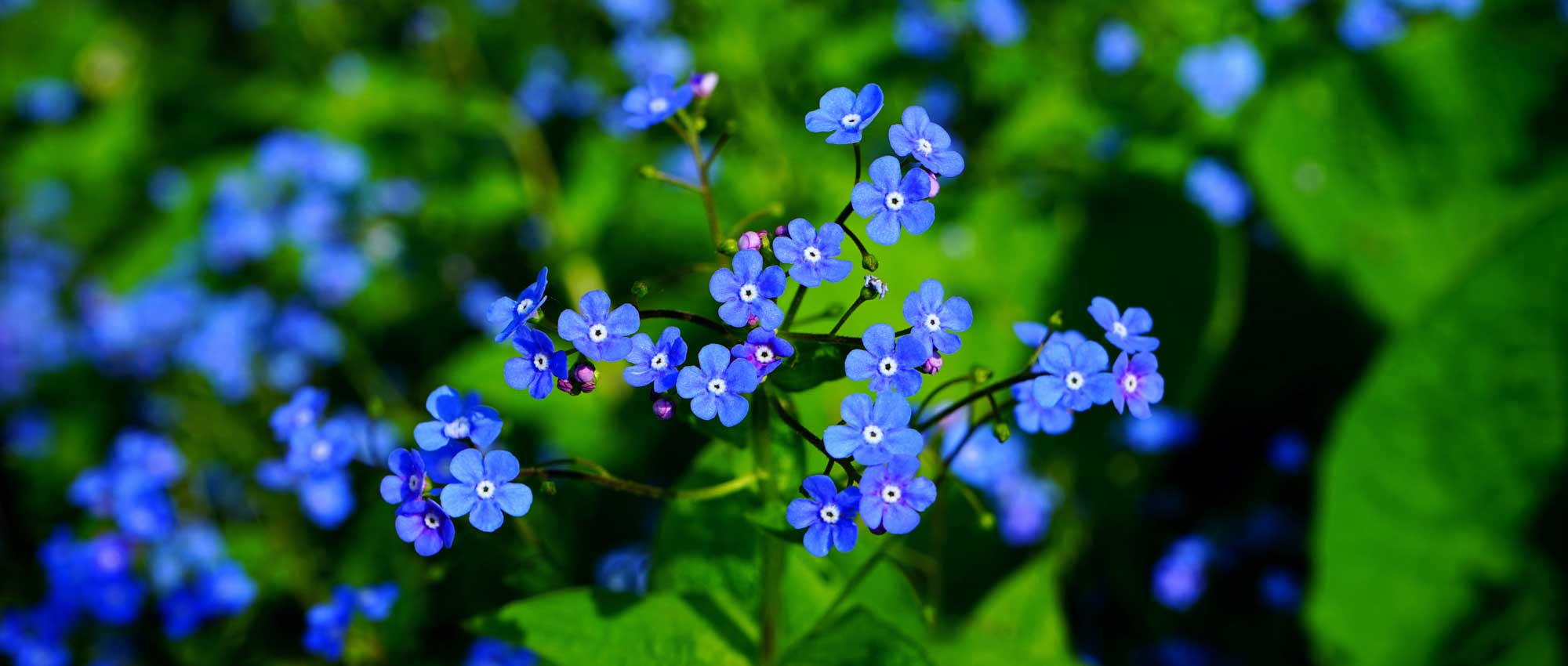
Brunnera, Myosotis of the Caucasus: planting, growing and maintenance
Contents
Brunnera in a nutshell
- Brunnera makes an excellent ground cover for shade
- It produces small blue flowers in spring, resembling forget-me-nots
- Its foliage is very decorative, often marked with silver or cream spots.
- It is a robust and reliable plant, very easy to grow
A word from our Expert
Brunnera is a perennial woodland plant that offers a lovely spring flowering and very decorative foliage. The blue, star-shaped, delicate flowers closely resemble those of forget-me-nots! They harmonise beautifully with the shades of the foliage. Brunnera forms dense and fairly wide clumps, making it an ideal ground cover. The cordate leaves are often dark green with silver-grey patterns, as seen in Brunnera ‘Jack Frost’.
Brunnera is among the most beautiful plants for shady gardens. It is a decorative perennial for almost the entire year, except in winter, as its foliage is deciduous. Its colours are fresh and rather light. It is valuable for bringing brightness to shaded areas of the garden.
Brunnera is a robust plant, rarely affected by diseases. It is very easy to grow and does not require much maintenance. It thrives in woodlands, on cool, humus-bearing soil, and is only sensitive to summer drought. With its dense and wide foliage, Brunnera is the perfect ground cover for shade! It prevents weeds from growing. It spreads gradually and tends to self-seed, thus being able to naturalise in the garden!
Botany
Botanical data
- Latin name Brunnera macrophylla
- Family Boraginaceae
- Common name Caucasian forget-me-not, Siberian bugloss
- Flowering April - May
- Height between 30 and 50 cm
- Exposure partial shade
- Soil type cool, humus-bearing
- Hardiness between -25 and -30 °C
The Brunneras are perennial plants of the undergrowth, native to the humid forests of Eastern Europe and north-western Asia (Caucasus, Turkey, Siberia…). Although there are three species of Brunneras, it is the Brunnera macrophylla that is by far the most cultivated. It has given rise to numerous horticultural varieties, selected for their ornamental qualities. The other two species are Brunnera sibirica and Brunnera orientalis.
As its common name (Caucasian forget-me-not) suggests, Brunnera macrophylla originates from the Caucasus. It grows spontaneously in the undergrowth of forests. This is why it is cultivated in shade in gardens, to recreate conditions similar to its natural habitat. The brunnera is also a very hardy plant.
The brunnera was named in honour of the Swiss botanist and physician Samuel Brunner (1790 – 1844). The species name macrophylla means “with large leaves”. The brunnera is closely related to Anchusa (bugloss), and is sometimes found under the synonym Anchusa myosotidiflora (= “bugloss with forget-me-not flowers”). In French, it is known as Caucasian forget-me-not, Caucasian bugloss, Siberian bugloss…
The brunnera belongs to the family Boraginaceae, the family of borage, phacelia, pulmonarias, and comfrey! It is very close to Anchusa as well as Myosotis. These three plants are very similar in terms of their flowering. They all bear small, star-shaped blue flowers with five lobes. The brunnera appears to be a perennial forget-me-not with large leaves!

Brunnera, Anchusa and Myosotis are three closely related plants! From left to right, Brunnera macrophylla, Anchusa azurea (photo Zeynel Cebeci) and Myosotis alpestris (photo Jerzy Opioła)
It is also quite striking to note the resemblance between the flowers of Omphalodes (another Boraginaceae) and those of the Brunnera. The flowers of the variety Omphalodes cappadocica ‘Starry Eyes’ (blue in the centre, white on the outside) seem to be the exact opposite of Brunnera ‘Starry Eyes’… It is no surprise that these two varieties share the same name!
The brunnera grows quite quickly and forms large clumps of dense foliage, slowing the growth of weeds. It makes an excellent ground cover for shady situations. It measures between 30 and 50 cm in height. The Brunnera sibirica is a vigorous species that spreads widely thanks to its running rootstocks, without becoming invasive.
Once well established, the brunnera can thrive for quite a long time in the garden. Moreover, it sometimes tends to self-seed and naturalise!
The brunnera flowers in spring, for about two months, usually in April and May. However, depending on the climate and the variety, flowering can start as early as March or last until June. The flower spikes emerge at the same time as the young leaves appear. By cutting off the faded flowers and watering the brunnera in summer, it may offer a second, later flowering (late summer – autumn).
The flowers of the brunnera have a very delicate hue. They are generally blue, the same blue as that of forget-me-nots! A light and soft blue, porcelain-like, nuanced by a small white circle in the centre. Although less common, some varieties offer pure white flowers. The flowers can also be bicoloured, blue and white, as seen in the variety ‘Starry Eyes’.
The light and airy flowering of Brunnera macrophylla (photo Agnieszka Kwiecień) / the bicoloured flowers of Brunnera ‘Starry Eyes’
By their shape and colour, the flowers of the brunnera are very similar to those of forget-me-nots. They are small, measuring between 4 and 8 mm in diameter, and have a very delicate appearance. They are star-shaped, divided into five fairly wide and rounded segments, which correspond to five fused petals. The reproductive organs (stamens and pistil) are not visible. The flowers of the brunnera are gathered in panicles, which reach about twenty centimetres in length. The flowering has a very light appearance: the flowers look like small blue stars floating above the foliage.
The flowering of the brunnera also has the advantage of being melliferous, attracting pollinating insects.
The brunnera is appreciated for its very decorative foliage! It is interesting for its colours and the patterns that form on the lamina. Moreover, the foliage is particularly dense. Thus, when well established, the brunnera prevents weeds from growing! It perfectly occupies the ground, leaving no space for them to develop.
The leaves are large and broad, heart-shaped (cordate), and measure up to 15-20 cm in length. The leaves are smaller before flowering and become larger afterwards. They are simple, entire, undivided. They form two lobes at the base, around the petiole, and end in a point at the tip. They have fairly rounded contours, with gentle curves. By their shapes and colours, the leaves of the brunnera can somewhat resemble those of hostas. The basal leaves are borne on a very long petiole… While the petiole shortens for the leaves inserted towards the top of the flower stem, which gradually become sessile (= without petiole, the lamina being directly attached to the stem).
The foliage has a rough, coarse, and pilous texture. The veins are well visible, raised, and give the leaf a wrinkled appearance.
The foliage is a rather dark green, but fresh at the same time, on which patterns of silver-grey colour emerge. It is common for the veins to stand out in green against the rest of the silver lamina, creating beautiful, very fine patterns, like lace. Some varieties have only grey spots, like Brunnera ‘Langtrees’, while others are almost entirely silver (Brunnera ‘Looking Glass’). There are also some varieties with light green foliage, or even golden yellow (Brunnera ‘Green Gold’). Finally, Brunnera ‘Dawson’s White’ has green leaves broadly margined with cream white. Thus, brunneras are valuable plants for bringing a lot of brightness and freshness to a woodland garden!

Brunneras offer varied foliage! From left to right, brunneras ‘Looking Glass’, ‘Dawson’s White’, ‘Jack Frost’ and ‘Green Gold’
The brunnera ‘King’s Ransom’ has the particularity of combining cream-margined leaves (like ‘Hadspen Cream’) on a silver background with green veins (like ‘Jack Frost’)! A surprising mix that makes the foliage very bright, like “frosted”.
There are very original and impressive varieties, such as ‘Looking Glass’, and brunneras with a much more natural, wild appearance. For a natural style garden, prefer the botanical species, such as Brunnera macrophylla or sibirica… or possibly, ‘Langtrees’.
The flowers are perfectly highlighted by the green of the foliage. These are two shades that harmonise wonderfully, giving a very fresh and natural appearance!
The only drawback of the brunnera is that its foliage is deciduous. It therefore disappears in autumn, and the young leaves reappear in spring, at the same time as the flower stems.
Although the brunnera gradually spreads through its rootstocks and by self-seeding, it is not an invasive plant.
The main varieties of Brunnera
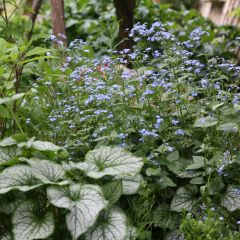
Brunnera macrophylla Jack Frost - Siberian Bugloss
- Flowering time June, July
- Height at maturity 50 cm
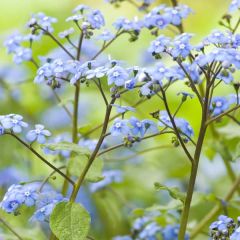
Brunnera macrophylla - Siberian Bugloss
- Flowering time May, June
- Height at maturity 45 cm
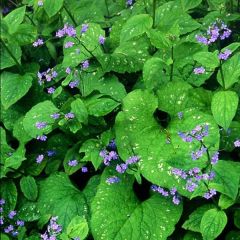
Brunnera macrophylla Langtrees - Siberian Bugloss
- Flowering time May, June
- Height at maturity 40 cm
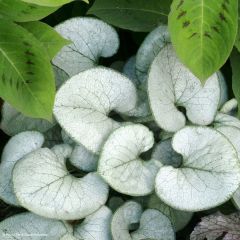
Brunnera macrophylla Looking Glass - Siberian Bugloss
- Flowering time May, June
- Height at maturity 40 cm
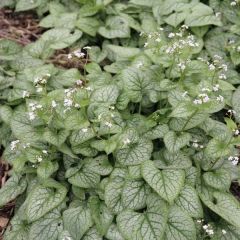
Brunnera macrophylla Mr Morse - Siberian Bugloss
- Flowering time April, May
- Height at maturity 40 cm
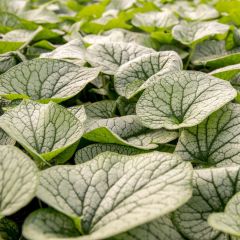
Brunnera macrophylla Alexanders Great - Siberian Bugloss
- Flowering time May to July
- Height at maturity 60 cm
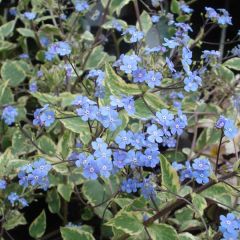
Brunnera macrophylla Hadspen Cream - Siberian Bugloss
- Flowering time April, May
- Height at maturity 40 cm
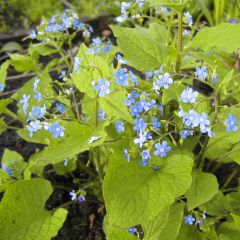
Brunnera macrophylla Green Gold - Siberian Bugloss
- Flowering time May to July
- Height at maturity 30 cm
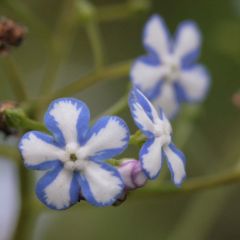
Brunnera macrophylla Starry Eyes - Siberian Bugloss
- Flowering time May, June
- Height at maturity 35 cm
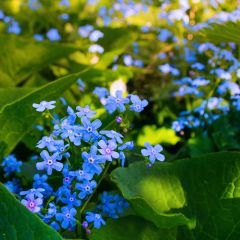
Brunnera sibirica - Siberian Bugloss
- Flowering time May, June
- Height at maturity 40 cm
Discover other Brunnera - Siberian Bugloss
View all →Available in 0 sizes
Available in 2 sizes
Available in 1 sizes
Available in 1 sizes
Available in 1 sizes

Available in 1 sizes
Available in 1 sizes
Available in 3 sizes
Available in 3 sizes
Available in 2 sizes
Young plantation
Where to plant?
As brunnera is a plant that naturally grows in woodlands, it will thrive if you place it in the shade of trees. The ideal situation is partial shade, for example, one that allows morning sunlight to filter through… Brunnera is perfect under deciduous trees. However, it can tolerate sun if the soil remains cool. In any case, avoid scorching situations. Silver or golden-leaved brunneras are valuable for bringing brightness to shaded corners of the garden. If you live in northern France, you can place it in the sun, whereas in a hot region, it is better to plant brunnera in the shade!
Brunnera will thrive in soil rich in humus. The ideal substrate is woodland soil. Don’t hesitate to add well-decomposed compost at the time of planting.
Brunnera needs cool soil. Avoid cultivating it if your land is particularly dry and stony. Unlike many plants, it tolerates clayey and fairly heavy soils. If planted in cool soil, brunnera will withstand a sunny situation.
You can plant brunnera in pots. However, you will need to be a bit more vigilant to ensure the substrate remains cool (more frequent watering than in open ground).
You can place brunnera in a perennial bed with spring flowering plants, in a border, or integrate it into a woodland garden for a very natural scene.
When to plant?
We recommend planting brunnera in autumn (October – November). This way, it will have time to settle in before winter, allowing it to flower in spring. However, it is also possible to plant it in early spring.
How to plant?
It is best to maintain a distance of about 40 cm between brunnera plants.
To plant your brunneras:
- Place the root ball in a basin filled with water.
- Dig a planting hole two to three times the size of the root ball. We recommend adding compost or well-decomposed manure, as brunnera loves soils rich in organic matter.
- Position your plant in the planting hole, with the collar level with the soil surface.
- Replace the substrate all around, then firm it down with the palm of your hand.
- Water generously.
Continue to water in the weeks following planting.
We suggest applying mulch at the base of your brunnera. This will help keep the soil cool and slow down the growth of weeds.
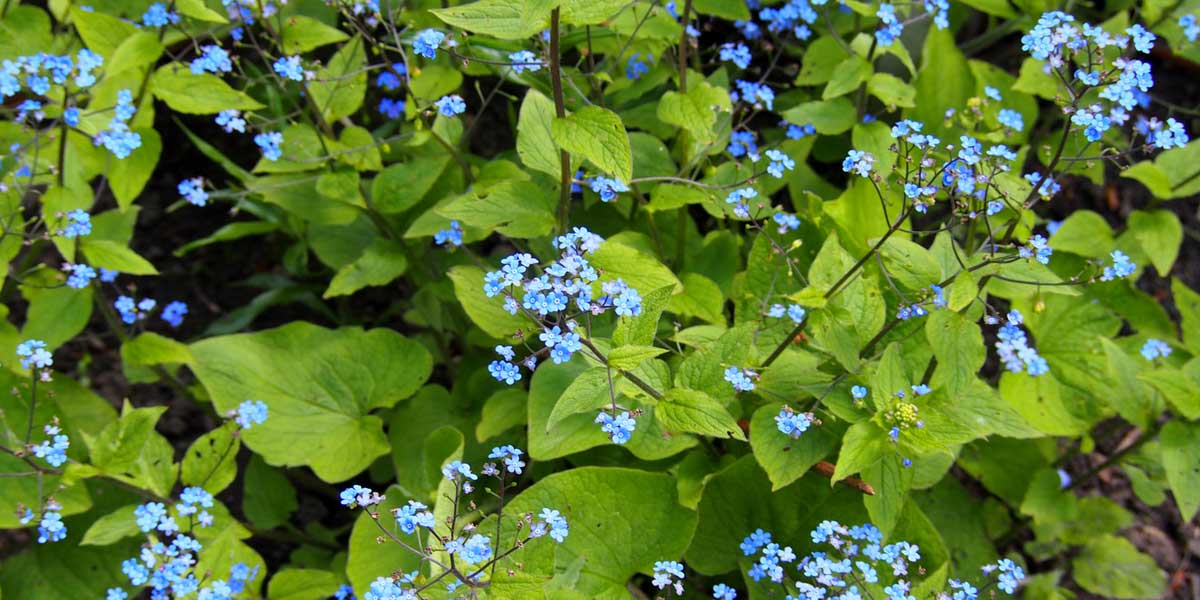
Read also
Heucheras: planting, growing and careMaintenance
Brunnera requires very little maintenance. As it enjoys a cool soil, you can water during the year of planting. Afterwards, it should manage without watering, except in cases of summer drought. Watering will need to be a bit more frequent if you are growing it in a pot, as the substrate dries out more quickly.
Feel free to add a bit of well-decomposed compost at the base of your brunneras each year to enrich the soil and promote generous flowering. Do this in autumn.
It is also advisable to cut the flower stems once they have faded. However, you can leave a few in place if you wish for the plant to self-seed.
We recommend placing a layer of mulch at the base of your brunneras: ramial chipped wood (RCW), dead leaves… This will enrich the soil with organic matter while limiting the growth of weeds and keeping the soil cool for longer! The conditions will be closer to those found in a forest, the natural habitat of brunneras.
The foliage tends to become less attractive in summer, which is why we advise cutting the old leaves at the base around August. This encourages brunnera to produce new, more aesthetically pleasing leaves. As brunnera is a deciduous plant, its foliage will then dry out in autumn. It is better to leave the dead leaves on the stump during the bad season, as they protect it, and only cut them at the end of winter.
Brunnera is not susceptible to diseases or pests. It sometimes happens that slugs and snails nibble on the foliage, but this is not very common. Brunnera is not their preferred plant!
Multiplication
We recommend vegetative techniques, such as clump division, although it is also possible to propagate brunneras by rooting the roots. It often happens that brunneras self-seed. You can collect the young seedlings from these spontaneous sowings to plant them in another location. However, plants from sowing may lose the specific characteristics of the variety (leaf variegation).
Clump Division
Brunnera is easy to divide. This technique has the advantage of being quite quick and allows for the preservation of true varieties. You can do this in autumn or late winter (March). Choose a substantial clump that has been in place for several years.
To divide Caucasian forget-me-not:
- Prepare pots with potting soil. Water them so that they are well moistened.
- Carefully dig up a clump that is at least three years old, taking care not to damage the root system.
- Clear away the excess soil around the roots.
- Cut the stump cleanly with a sharp knife to obtain several fragments.
- It is preferable to remove some of the leaves, keeping only a few to balance the volume of the roots and foliage.
- Replant the fragments from the division, and firm the soil around them to ensure good contact between the roots and the substrate.
- Be sure to water well.
Associating Brunnera in the garden
For a very natural scene, brunnera can be planted in woodland alongside ferns, hostas, and epimediums. Also favour plants that are found naturally in forests in France: Paris quadrifolia, Allium ursinum, sweet woodruff (Gallium odoratum), bluebells (Hyacinthoides non-scripta), Solomon’s seal… Enjoy the white flowers of the wood anemone (Anemone nemorosa). Brunneras also pair very well with pulmonarias, plants that are very similar, which also have decorative foliage and spring flowering in the same tones. Their use and growing conditions are quite similar!
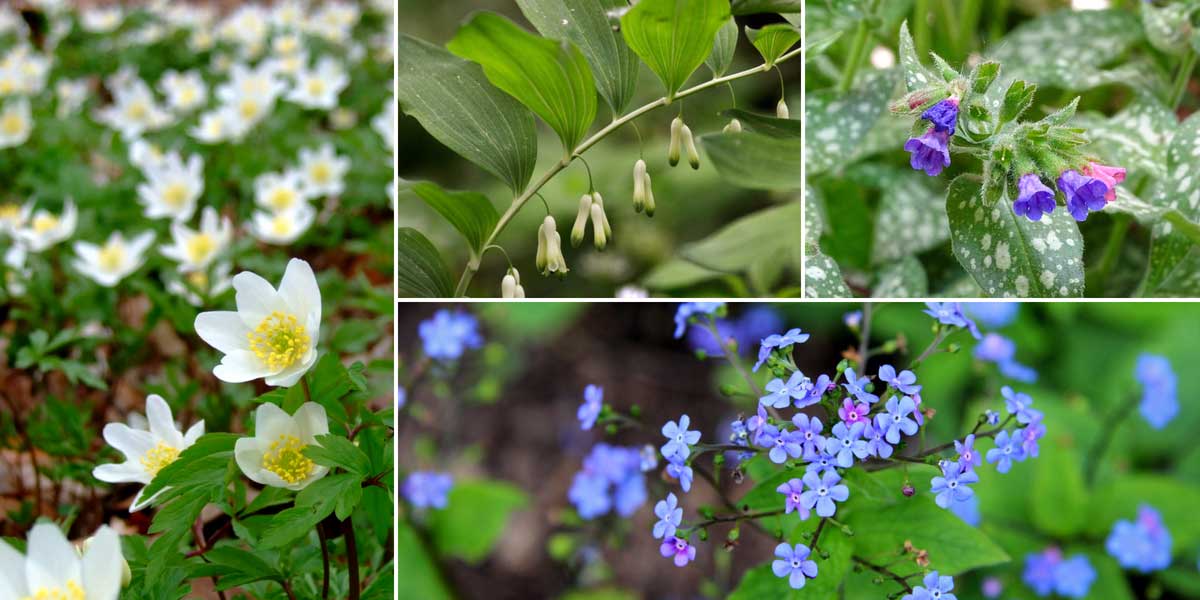
An idea for a woodland association: Anemone nemorosa (photo Pandano), Polygonatum multiflorum (photo Radio Tonreg), Lungwort and Brunnera macrophylla (photo Maulaff)
As it enjoys cool, even damp environments, you can place brunnera near a water feature, a pond, or a small stream, alongside ferns, Iris pseudacorus, and Asian primroses. You will create a very calming space, ideal for recharging!
Brunnera can also be planted in borders to create a stunning spring scene, with primroses (such as Primula veris, the cowslip, or Primula denticulata), and spring bulbs. Pair it, for example, with the elegant and delicate flowering of botanical tulips, squills (such as Scilla siberica), muscari, and daffodils (Narcissus poeticus). Brunnera is perfect for accompanying other fairly free, natural plants, such as columbines.
To create contrasts of shapes and colours, you can combine brunnera with other decorative foliage. Plant it with hostas, ophiopogons, luzulas, and pulmonarias. Also discover the unique foliage of Paris polyphylla. You can achieve a stunning contrast effect with the golden foliage of Lysimachia nummularia. Also enjoy sedges, particularly the fine and bright foliage of Carex oshimensis ‘Evergold’.
You can also combine brunnera with spring-flowering shrubs. Place it alongside the white flowers of Deutzia, spireas, or some viburnums, such as Viburnum burkwoodii and Viburnum plicatum.
→ Discover 5 more ideas for combining Brunnera in our advice sheet.
Useful resources
- Discover our wide range of brunneras!
- Also discover our advice sheet – Successfully planting the Caucasian forget-me-not
- Our article to help you choose a Brunnera: our buying guide
- Discover the most beautiful varieties of silver-leaved Brunnera
- Subscribe!
- Contents
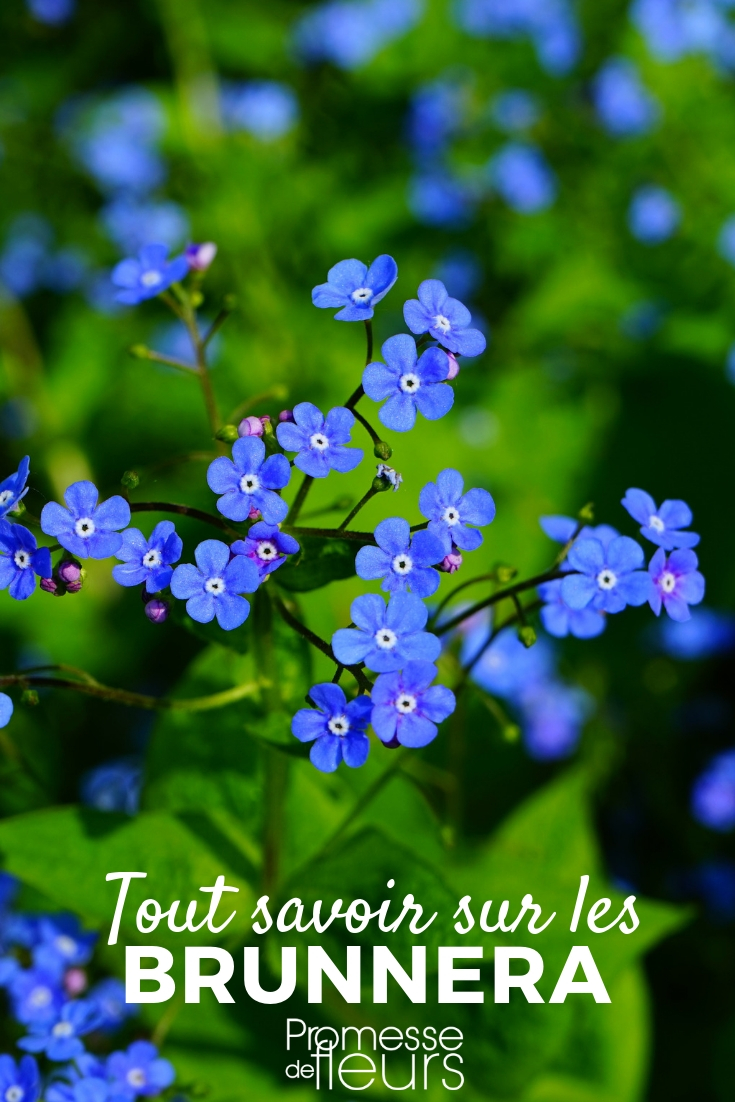































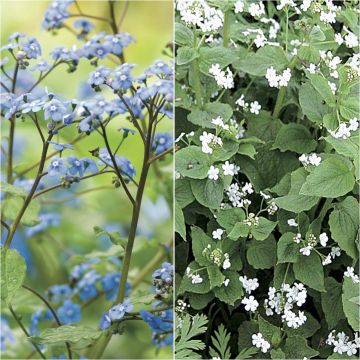

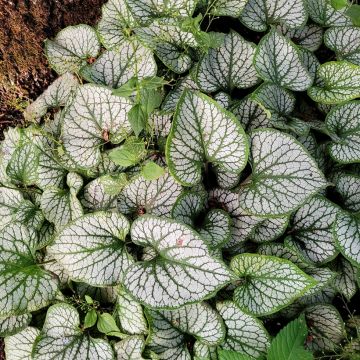
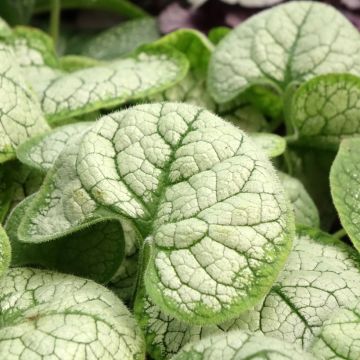
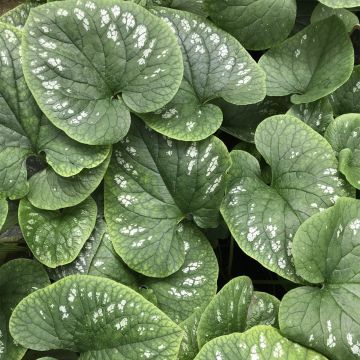




Comments